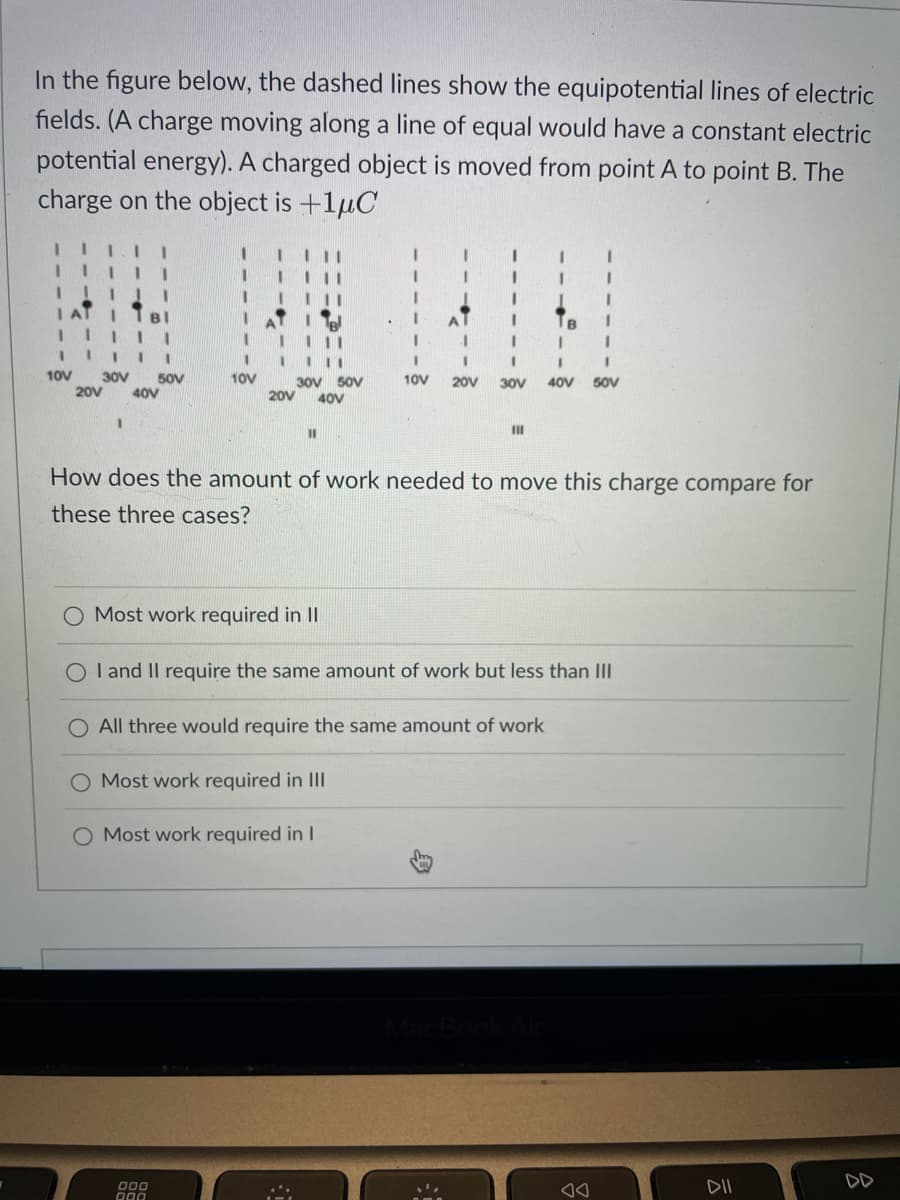In the figure below, the dashed lines show the equipotential lines of electric fields. (A charge moving along a line of equal would have a constant electric potential energy). A charged object is moved from point A to point B. The charge on the object is +1μC I I! IAT I 10V 1 BI III 30V 50V 20V 40V 10V 1 1111 11 30V 50V 20V 40V 11 I Most work required in II I. 10V 20V I I I 1 40V 50V 30V III How does the amount of work needed to move this charge compare for these three cases? OI and II require the same amount of work but less than III O All three would require the same amount of work O Most work required in III O Most work required in I
In the figure below, the dashed lines show the equipotential lines of electric fields. (A charge moving along a line of equal would have a constant electric potential energy). A charged object is moved from point A to point B. The charge on the object is +1μC I I! IAT I 10V 1 BI III 30V 50V 20V 40V 10V 1 1111 11 30V 50V 20V 40V 11 I Most work required in II I. 10V 20V I I I 1 40V 50V 30V III How does the amount of work needed to move this charge compare for these three cases? OI and II require the same amount of work but less than III O All three would require the same amount of work O Most work required in III O Most work required in I
College Physics
11th Edition
ISBN:9781305952300
Author:Raymond A. Serway, Chris Vuille
Publisher:Raymond A. Serway, Chris Vuille
Chapter16: Electrical Energy And Capacitance
Section: Chapter Questions
Problem 3CQ: Figure CQ16.3 shows equipotential contours in the region of space surrounding two charged...
Related questions
Concept explainers
Dielectric Constant Of Water
Water constitutes about 70% of earth. Some important distinguishing properties of water are high molar concentration, small dissociation constant and high dielectric constant.
Electrostatic Potential and Capacitance
An electrostatic force is a force caused by stationary electric charges /fields. The electrostatic force is caused by the transfer of electrons in conducting materials. Coulomb’s law determines the amount of force between two stationary, charged particles. The electric force is the force which acts between two stationary charges. It is also called Coulomb force.
Question

Transcribed Image Text:In the figure below, the dashed lines show the equipotential lines of electric
fields. (A charge moving along a line of equal would have a constant electric
potential energy). A charged object is moved from point A to point B. The
charge on the object is +1μC
1
10V
I I 1
30V 50V
20V 40V
1 1 111
10V
30V 50V
20V 40V
11
O Most work required in II
000
000
Most work required in III
Most work required in I
I
I
1
1
I
I
10V 20V 30V 40V 50V
How does the amount of work needed to move this charge compare for
these three cases?
I
III
OI and II require the same amount of work but less than III
O All three would require the same amount of work
I
1
I
AA
ㅎ
DII
Expert Solution
This question has been solved!
Explore an expertly crafted, step-by-step solution for a thorough understanding of key concepts.
This is a popular solution!
Trending now
This is a popular solution!
Step by step
Solved in 4 steps with 2 images

Knowledge Booster
Learn more about
Need a deep-dive on the concept behind this application? Look no further. Learn more about this topic, physics and related others by exploring similar questions and additional content below.Recommended textbooks for you

College Physics
Physics
ISBN:
9781305952300
Author:
Raymond A. Serway, Chris Vuille
Publisher:
Cengage Learning

Principles of Physics: A Calculus-Based Text
Physics
ISBN:
9781133104261
Author:
Raymond A. Serway, John W. Jewett
Publisher:
Cengage Learning

Physics for Scientists and Engineers: Foundations…
Physics
ISBN:
9781133939146
Author:
Katz, Debora M.
Publisher:
Cengage Learning

College Physics
Physics
ISBN:
9781305952300
Author:
Raymond A. Serway, Chris Vuille
Publisher:
Cengage Learning

Principles of Physics: A Calculus-Based Text
Physics
ISBN:
9781133104261
Author:
Raymond A. Serway, John W. Jewett
Publisher:
Cengage Learning

Physics for Scientists and Engineers: Foundations…
Physics
ISBN:
9781133939146
Author:
Katz, Debora M.
Publisher:
Cengage Learning

Physics for Scientists and Engineers, Technology …
Physics
ISBN:
9781305116399
Author:
Raymond A. Serway, John W. Jewett
Publisher:
Cengage Learning


Physics for Scientists and Engineers with Modern …
Physics
ISBN:
9781337553292
Author:
Raymond A. Serway, John W. Jewett
Publisher:
Cengage Learning